MAGICAL TOWNS IN CHIAPAS
Magical Towns of CHIAPAS
Chiapas has 4 magical towns: San Cristóbal de Las Casas, Chiapa de Corzo, Comitán de Dominguez and Palenque, this recognition is given to the localities that have a special charm and unique symbolic attributes that allow to highlight the character and identity of the town, which they are manifested through their cultural heritage. Some of these characteristics can be: history, architecture, gastronomy and crafts, making your stay a magical moment.
PALENQUE
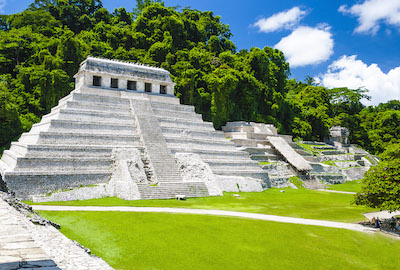
The origins of this Magical Town in the state of Chiapas go back to the integration of several Chol families dispersed in the Lacandon Jungle, achieved by the Dominicans. Before that, the town was known by the name of Otulún, which in the Chol language means “fenced or fortified place”, a quality that can be corroborated by contemplating the dense vegetation that surrounds it.
Palenque is believed to have been founded around 100 BC. of C. and that its development lasted almost a thousand years, after which it was abandoned forever. The buildings that can be seen today in the magnificent jungle setting are from the Classic Period, from 400 to 700 AD. by C.
The findings found at this site confirm that the Maya had a complex social and religious organization, as well as admirable architectural, astronomical, and mathematical knowledge. The hieroglyphs on its walls speak of the military history of the city, the exploits of its rulers, its calendar and its rituals, thus providing invaluable information on the Mayan culture.
SAN CRISTÓBAL DE LAS CASAS
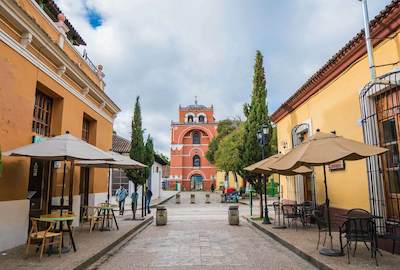
Magic is the fundamental ingredient of this mountainous Mexican town located in the state of Chiapas, whose rich culture and its beautiful streets please the most demanding visitors. With a relaxed atmosphere and surrounded by natural attractions, it stands out for its colonial essence and also concentrates a large number of attractions around the Zócalo.
However, it retains a marked indigenous character that can be seen in the traditional iridescent dresses and the low houses with Roman tiles. In the surrounding forests, in addition, Subcomandante Marcos led the Zapatista rebels.
Travel to San Juan Chamula to appreciate the syncretism of the indigenous people of the Tzotzil people, who combine Christianity with animist beliefs, or visit beautiful places, such as the viewpoints of the churches of Guadalupe and San Cristóbal, the Huitepec nature reserve and the park ecotourism El Arcotete, are part of its tourist claims.
CHIAPA DE CORZO
Chiapa de Corzo is one of the most beautiful colonial cities of Chiapas, located just 15 minutes from Tuxtla Gutierrez, along the Grijalva River. It was the first city founded by the Spanish Conquerors in Chiapas in the sixteenth century. This is a place full of history, tradition and culture.
The city is also distinguished by its variety of crafts such as lacquer technique whose tradition dates back to Pre-Hispanic times and it is also known as maque, woodcarving, particularly Parachico masks, and embroidery. This beautiful work can be seen in the colorful costumes of Chiapas.
You can stroll around the central square and enjoy this colorful handcrafts and enjoy exquisite local cuisine, including: cochinito horneado (cooked hog), the typical candy, such as the suspiros (breaths), the chimbos and the nuegados, and traditional the delicious beverage called “Pozol”, a drink made from fermented corn dough. You can visit the Archaeological Zone.
Parachicos Tradition
The Fiesta Grande de Enero (Great January Feast) takes place from 4 to 23 January every year in Chiapa de Corzo, to honor local patron saints Our Lord of Esquipulas, Anthony the Great and Saint Sebastian. The Fiesta Grande de Enero is a celebration, which joins a number of events that includes music, dance, crafts, food, religious ceremonies and other entertainment. But the main attraction is the Parachicos dancers.
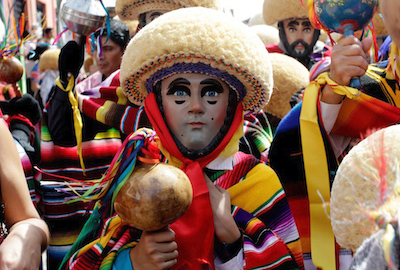
The Parachicos dress in a mask carved of wood and decorated with lacquer to mimic a Spanish face; a helmet or wig made of ixtle to mimic blonde hair; and a Saltillo style sarape. The dancers carry a type of maraca made of metal called chinchin to make noise along with the taping of their boot heels.
The dancers go along the streets dancing with a drum and a “carrizo” also called reed whistle. These processions visit the various churches on their path, which are decorated with branches, on which are hung breads, sweets, fruits and plastic decorations.
Their dances begin in the morning and end at night. There are so many parachicos dancers (more than 50 percent of the population go out for dancing), which require guidance, a “patron”. The “patron” of the dances and processions has a mask with a severe expression, a guitar and a whip, and the musicians play flutes, drums and whistles. During the dance, the “patron” chant prayers and the Parachicos respond with cheers.
The dance is transmitted and taught during the festivity, children who participate in the festival, mimic the movements of adults, also the art of making masks is transmitted from generation to generation. The festival has been included in UNESCO’s Intangible Cultural Heritage Lists on 2010, listed as Parachicos in the traditional January feast of Chiapa de Corzo.
Tourist Attractions in CHIAPA DE CORZO
La Pila Mudejar Fountain
This was constructed in 1562 in Moorish style, made of brick in the form of a diamond. It has eight arches and a cylindrical tower.
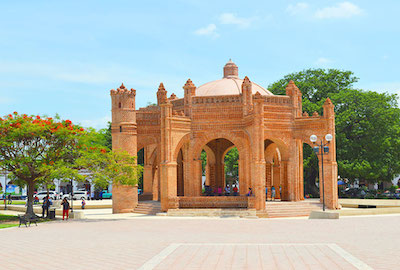
The Santo Domingo Church and Former Monastery
Is the largest structure in the town, is one of the best preserved from the 16th century in Chiapas. It is based on the Moorish churches of the Seville region in Spain, but it also has Gothic, Renaissance and Neoclassical influences. Its main bell tower has the largest bells in the country. The former Dominican monastery exhibits various art forms.
The Calvario Church
It is from the 17th century. It was remodeled in Gothic Revival architecture at the beginning of the 19th century. Another treasure of this church is a wooden relief illustrating The Descent from the Cross.
San Sebastian
It is a church in ruins located on the San Gregorio hill. It was constructed in the 17th century. Only its apse and facade remain with elements of Moorish, Renaissance and Baroque style.
Museo de la Marimba (Marimba Museum)
The museum belongs to the Nandayapa Vargas family, who follow the family tradition as manufacturers of this instrument. The friendly family will take you around the workshop to show you how this musical instrument is made.
Chorreadero Waterfall
Beautiful waterfall of 25 meters high, located just 9 miles from Chiapa de Corzo. The best season for visit the waterfall goes from November through March.
It is a geological fault formed about 30 millions of years ago. The vertical walls rising up to 1000m (3,000 ft.) are lush with plants, abundant waterfalls and caves, is one of Mexico’s most spectacular landscape.
Chiapa de Corzo Archeological Site
It is one of the most important archaeological sites in the central region of Chiapas. At its peak, it counted about 200 structures, but was abandoned around 500 AD. Today the site has near 100 mounds. Recent excavations link this site with Olmec centers such as La Venta and the highlands of Guatemala. Opening hours: Tuesday to Sunday: 9:00 to 16:00.
COMITÁN DE DOMÍNGUEZ
An endearing land, pride of all Chiapas, which constitutes the expression of a promising Chiapas, of respect, work and peace. Flavors, climates, flowery patios, luminous horizons next to Mayan temples and magnificent colonial churches, are the elements that make Comitán and its region, the old plains of colonial geography and an area that accounts in a short extension, of the natural diversity and cultural complexity of Chiapas.
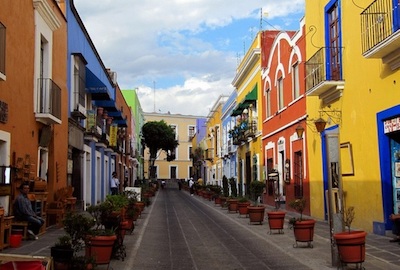
The pre-Hispanic name of Comitan was Balún Canán, which means: “Place of the nine stars”. The old town was founded in a swamp by a large group of indigenous Tzeltals. In 1486 it was subdued by the Aztecs who called it Comitán, from the Nahuatl komitl-tlán and which means: “Place of fevers”.
In 1556, the missionary Diego Tinoco moved the town of Comitán together with a large group of Tojolabal Indians, to the current location; in 1625 he was renamed “Santo Domingo de Comitán” and on September 3, 1915, the surname Domínguez was added, in memory of the Mexican doctor and politician, Belisario Domínguez Palencia.
Considered as the cradle of independence, it is the heart of the tourist region of Los Llanos; renowned for its traditional architecture of houses with roofs and neoclassical touches. The city of Rosario Castellanos, grew thanks to the haciendas and became one of the main cities of the colonial province.
To walk through its streets is to return to a colorful past, as it is a city full of testimonies of centuries of history; Who visits it will be able to approach the great sites of comiteca personality. Also to be mentioned, as a mandatory point of visit, is the famous neighborhood of the 7 corners, where many samples of the traditional Comiteca culture are preserved and whose setting is framed by the beautiful Temple of San Caralampio.
Tourist Attractions in Comitán de Domínguez
Santo Domingo Church
It was built between the 16th and 17th Centuries, with a Moorish style. The stained glass windows give accents of color to the sober interior. The celebration of Santo Domingo during August takes place in this temple. Its former monastic buildings next door are now the Centro Cultural Rosario Castellanos, which has a pretty wood-pillared patio, home of the Archaeological Museum of Comitan.
The San Caralampio Church
It was built in 1852 in a Neoclassic style, although the decoration has a native influence. One of the traditions of the place is to celebrate San Caralampio from 11 to 20 of February.
San José Church
Beautiful Gothic church built in the early 20th century combining the classic architecture with some typical elements of the culture of Chiapas.
San Sebastian Temple
The church construction dates back to the early 17th century. It has a Baroque style.
Dr. Belisario Dominguez Museum
A typical nineteenth century mansion that exhibits the life and work of this illustrious martyr. Opening hours: Monday to Friday: 10:00 to 19:00 hrs.; Saturday and Sunday: 9:00 to 13:00 hrs.
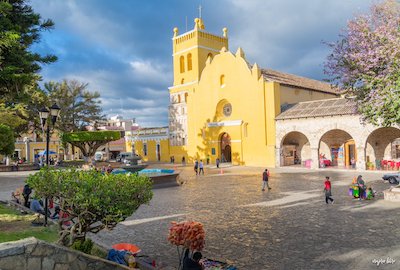
Hermila Castellanos Dominguez Art Museum
The museum exhibits works of artists such as Rufino Tamayo, Francisco Toledo and Gunther Gerzso. It has rooms for temporary exhibitions, for paint and plastic arts workshops, and for concerts and conferences. Opening hours: Tuesday to Saturday: 10:00 to 17:30 hrs.; Sunday: 10:00 to 14:00 hrs.
Museo Arqueológico de Comitán (Archaeological Museum)
Displays various objects found in archaeological sites in the region. Opening hours: Daily: 9:00 to 17:00 hrs.
Rosario Castellanos Cultural Centre
It is located in a former Dominican convent built in 1552. Today is a House of Culture, offering a variety of courses related to the visual arts, theatre, film and music.
Benito Juarez Park
Located in the heart of Comitan, is a beautiful place with trees, statues and a gazebo. Every Thursdays and Sundays you can enjoy live marimba music in the park.
Passage Morales
A pedestrian alley with candy shops, boutiques, cafes and much more.
Junchavin City Theatre
Built in the early 20th century, this theater host the most important events of the city.
The former convent of Copanahuastla
Considered one of the most important colonial monuments in Chiapas.
Parador Santa Maria Museum
Located 30 minutes from Comitan, dates from the XIX century and its interiors are decorated throughout with period furniture and works of art covering many centuries, creating an evocative and exclusive atmosphere.
Map of the Magic Towns of CHIAPAS
More Tourist Attractions in CHIAPAS
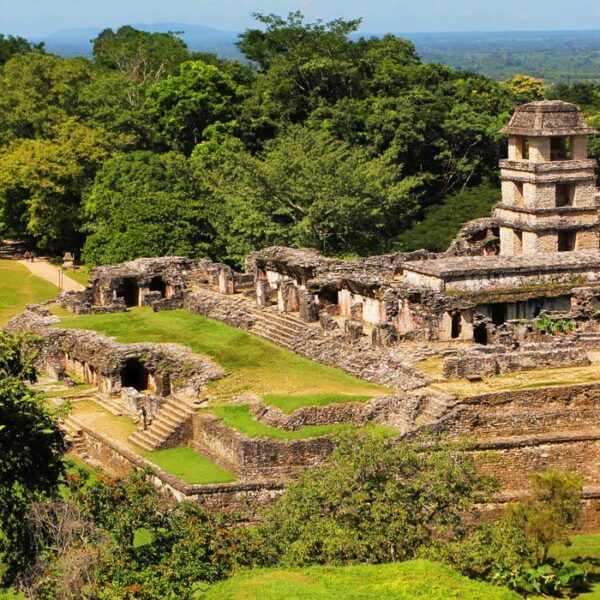
Palenque
Palenque is a Chiapas city of Mayan origin, head of the municipality of the same name located in the north of the state. The indigenous population is formed mainly by the Chol, Tzeltal and Lacandon ethnic groups. The municipality borders Guatemala to the southeast, has three border sectors with the state of Tabasco and is also a neighbor of the Chiapas municipal entities of Catazajá, La Libertad, Ocosingo, Chilón and Salto de Agua. The closest cities to Palenque are Villahermosa, Tabasco, located 145 km to the west and San Cristóbal de las Casas, which is 219 km to the south.… Read More
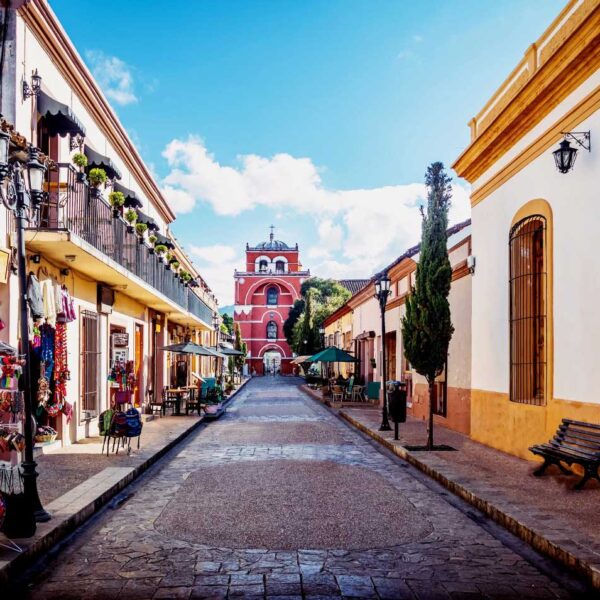
San Cristobal de Las Casas
San Cristóbal de las Casas is one of Mexico’s most beautiful colonial towns. Through its peaceful cobblestone streets, flanked by houses with slanted red tiled roofs and patios full of flowers, one discovers religious monuments with influence from Mexican and Central American colonial art, giving it a peculiar frontier town character. Indigenous people come to its busy markets from the surrounding hamlets to offer textiles, ceramics, fruits and vegetables.… Read More

Ecotourism and Adventure in Chiapas
Ecotourism in Chiapas is currently one of the most popular tourist trends in the state, with activities that try not to alter nature, thus preserving the ecosystem, flora and fauna, while encouraging sustainable development processes in indigenous communities that remain in the region. Responsibly enjoy a vacation in Chiapas and discover the hidden secrets of the state such as impressive natural sanctuaries and indigenous communities in the heart of the jungle where ancestral traditions still try to survive.… Read More
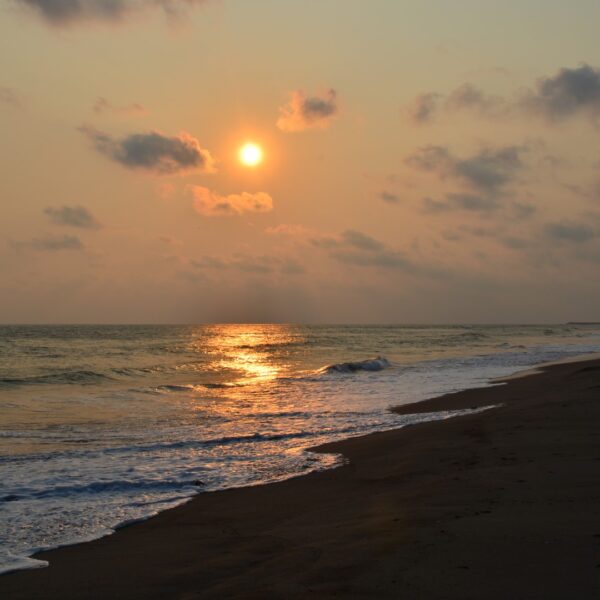
Beaches in Chiapas
The Chiapas coast offers beautiful beaches where you can do a wide variety of water sports. There are beaches of great beauty that are characterized by their tranquility and that are ideal for you to relax and enjoy nature. However, it must be taken into account that many of them face the open sea, so the waves tend to be high and you must be careful to enjoy these waters. Part of the coastal area is immersed in the La Encrucijada Biosphere Reserve, so if you are a lover of venturing into nature, this is one of the places with more options, where you can find some of the largest red mangroves in all of America that are located in a series of estuaries that make the landscape unique.… Read More
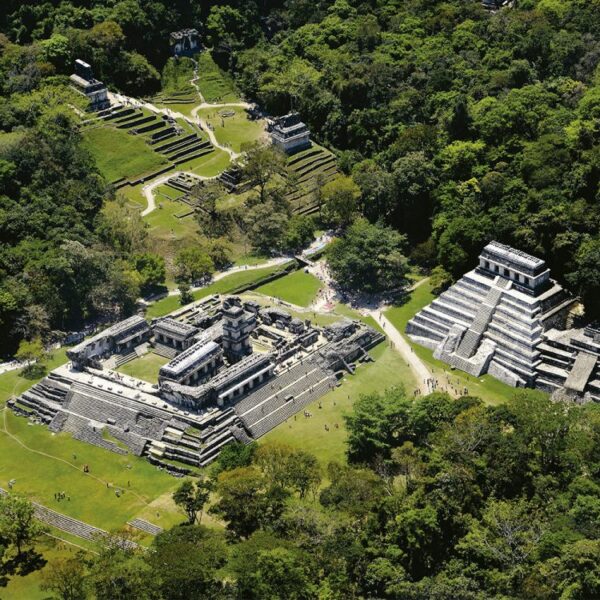
Archaeological Sites in Chiapas
In Chiapas the forests and the jungle are a beauty, spectacular settings for archaeological sites. The incredible nature that accompanies many of these areas is a plus. Visits to archaeological sites are part of nature tourism, due to the opportunity to walk around diverse natural environments. In several of these places you can see animals, or hear them. They are places that also give us the opportunity to connect with nature, and that hand in hand with culture is an excellent combination.… Read More
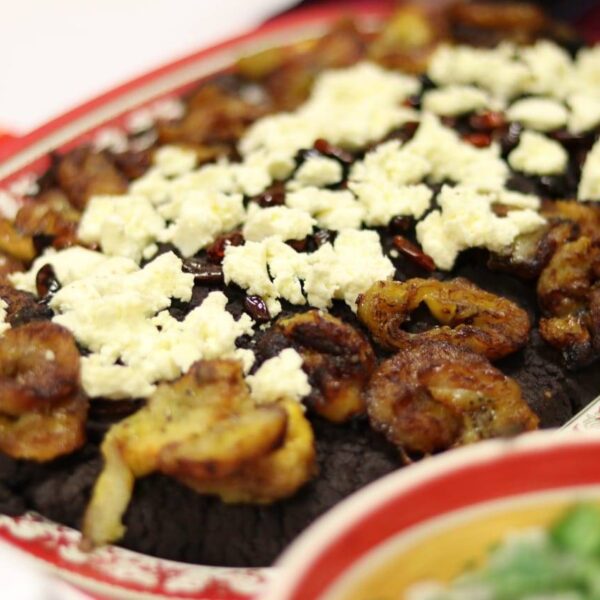
Gastronomy of Chiapas
Chiapas food has certain features of authenticity, it is a gastronomic mosaic made up of its natural biodiversity, where each place prints its own characteristics, defines tastes and creates habits; varies in each region; Likewise, it is nourished by the diversity of Mayan ethnic groups and the Zoque of Olmec origin that when combined with Spanish cuisine by the influx of Dominican monks; It results in an immense variety of dishes of miscegenation typical of the State.… Read More
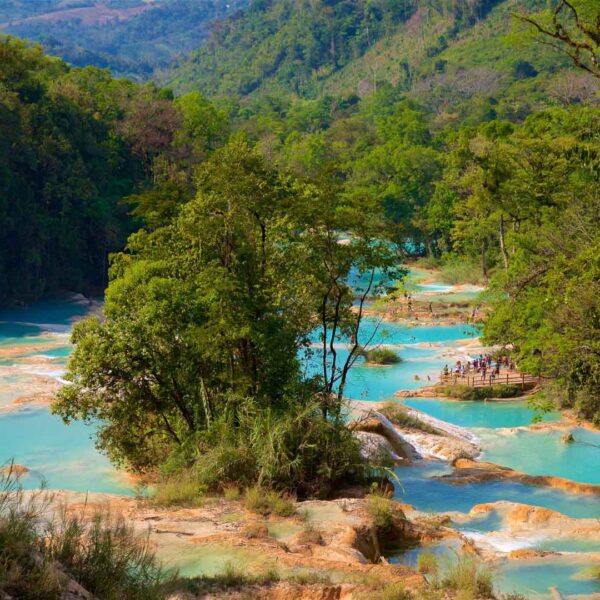
Tapachula and Tonala
Tapachula and Tonalá will amaze you with their beautiful buildings, their people and their traditions, colonial monuments, and breathtaking landscapes. Tapachula is also known as “La Perla del Soconusco” (The Pearl of Soconusco), it is a modern city with beautiful buildings built in a classic style. Located just next to the border with Guatemala, almost at the foot of the volcano Tacaná. Tonalá is a city in the southwest of Chiapas and head of the IX Istmo-Costa region; considered the third city in economic importance of the state; It is located in the transition of the Pacific Coastal Plain and the Sierra Madre de Chiapas.… Read More
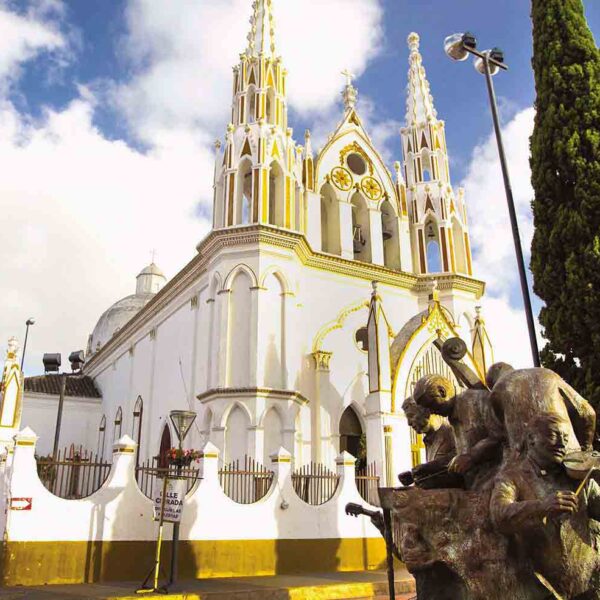
Tuxtla Gutierrez
It is the capital city of the State of Chiapas. Its climate is hot and semi-humid. Tuxtla Gutiérrez is a modern city where culture and traditions of Chiapas blend together. The streets in Tuxtla contain a combination of past and present. It is a beautiful city surrounded by lush vegetation. In downtown there is the Central Park and the beautiful Marimba Park. During the evenings you can stroll around this park and enjoy the marimba music played at the gazebo. There are many natural wonders nearby Tuxtla and the city offers very good touristic infrastructure, but most of all, the city offers the warm and kindness of the people.… Read More
Guided Tours in CHIAPAS
Flights & Hotels in CHIAPAS
More Tourist Attractions in MEXICO

Beaches
On the Beaches of Mexico you can immerse yourself in the intense blue ocean of the Pacific bays, sunbathe on the shore of the warm and transparent waves of the Caribbean Sea in Quintana Roo or even rest on the beautiful coasts of the Gulf of Mexico. Mexican beaches hide wonderful secrets for the traveler. By visiting them, in addition to enjoying the excellent climate and water activities, you can discover splendid archaeological sites and interesting colonial cities without traveling long distances.… Read More

Traditions in Mexico
It is practically impossible to make a meticulous, and above all, accurate selection of the places to visit in Mexico. Each place that our country houses is unique and beautiful in its own way. Mexico, with its nearly 2 million km², has a large number of scenarios to offer, as well as endless activities to do. Do not lose your way and enter the places to visit in Mexico. In Mexico, apart from the beaches and its famous archaeological sites, there are many other really interesting sites and activities that you should know. In the surroundings of the main cities you will find places full of culture and tradition, where you can spend relaxing, interesting and fun vacations. On your trip through Mexico you cannot stop obtaining souvenirs, the crafts that are made here are of the highest quality and recognized worldwide. A shopping tour cannot be missed.… Read More

Capital Cities
Folklore, gastronomy, literary culture, art and exhibitions, is what you will find in the capitals of the states of Mexico. To the north, colonial Mexico, Puebla, Guadalajara, Guanajuato, the Sonoran desert and the California peninsula. To the east Veracruz and the gulf. To the west Acapulco, Oaxaca and Tuxtla Gutiérrez. And to the south the Riviera Maya and the pyramids of Chichén-Itzá, Tulúm and Cobá in Yucatán, Palenque in Chiapas, the cenotes, and the Central American jungles.… Read More

Gastronomy
The Gastronomy of Mexico has a great diversity of typical dishes, which is why it was recognized by UNESCO as Intangible Heritage of Humanity. The basic and representative ingredients of Mexican dishes are: corn, coriander, chili, beans, piloncillo, nopal and tomato. Mexican cuisine is also characterized by its sauces, which serve as an accompaniment to traditional dishes, prepared based on spices.… Read More

Archaeological Sites
The Archaeological Zones are the cultural past of every Mexican. You will be amazed at the ambient, nature and the environment that surrounds them. Climbing to the top or being around it will take us back in time to admire every detail. México is a country of culture and traditions, many of which we have inherited from the pre-Hispanic inhabitants of this vast territory, although it is true that there were more settlements in the central and southern part of the country, it is also possible to find some archaeological remains in the north.
… Read More

Ecotourism and Adventure
Mexico is one of the best countries for Ecotourism as it has a great variety of flora and fauna, as well as a large number of refuges for extraordinary species. You can enjoy recreational activities of appreciation and knowledge of nature through contact with it, such as: stargazing, observation of natural attractions, wildlife and bird watching. Throughout México there are more than 176 protected natural areas, 5 of them considered by UNESCO as Natural Heritage of Humanity. Just for this and much more, we believe that Mexico is a Paradise for Ecotourism.… Read More

States Of Mexico
Mexico has an incredible diversity of landscapes, where the beauty of its beaches, internationally recognized, stands out. In its vast territory of coasts, there are beaches of unparalleled beauty, and colorful landscapes. A large network of first-class hotels and tourist services is available to visitors to these beaches. Mexico is also mystical places, dotted with archaeological testimonies inherited from its original inhabitants. Monuments made by the Mayas, Aztecs and Toltecs are located in magical landscapes, like lighthouses in an ocean of natural beauty. They offer visitors buildings that tell their history, and museums that collect their cultural heritage. And that keep alive ancestral traditions, in ceremonies and festivals, where you can enjoy cultural activities and entertainment.… Read More

Magical Towns
A Magical Town is a place with symbols and legends, towns with history that in many cases have been the scene of transcendent events for our country, they are places that show the national identity in each of its corners, with a magic that emanates from its attractions ; visiting them is an opportunity to discover the charm of Mexico. The Magical Towns Program contributes to revalue a set of populations in the country that have always been in the collective imagination of the nation and that represent fresh and varied alternatives for national and foreign visitors. A town that through time and in the face of modernity, has conserved, valued and defended its historical, cultural and natural heritage; and manifests it in various expressions through its tangible and intangible heritage. A Magical Town is a town that has unique, symbolic attributes, authentic stories, transcendent events, everyday life, which means a great opportunity for tourist use, taking into account the motivations and needs of travelers.… Read More

